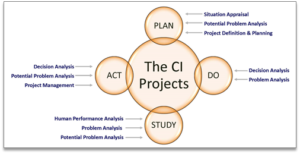Continuous Improvement (CI) is moving to the front lines of education. Many school districts have launched CI initiatives at the district-wide level and had great success. As a result, in recent years there has been a logical transition to push CI into the classroom. As these initiatives have fanned out to the schools it is a natural progression for teacher leaders and teachers to take on problems and make decisions as part of the CI efforts that affect their schools and classrooms and to troubleshoot root cause.
Now, it is becoming clear that teacher leaders and teachers need a fundamental set of CI tools and a robust understanding of “how to” use these tools to positively affect their schools, their classrooms and drive CI.
Continuous improvement initiatives are typically supported by the Plan-Do-Study-Act (PDSA) framework, a model based on the work of Dewey and Shewhart. This framework is an iterative, four-stage, CI model used for improving a process or carrying out a change through the interaction of systems, people, process and variation. The PDSA framework is often used to guide continuous improvement in district wide, school based or instructional improvement initiatives. It can be very successful, however, without the knowledge and use of a few fundamental, critical thinking tools, PDSA will be sub-optimized and most likely will not deliver the expected results. At TregoED, we work with teacher leaders and teachers in learning and applying the “How To” tools that enhance and help drive the CI initiative within a PDSA framework. These “critical few” tools focus on addressing and resolving complex issues, solving tough problems, making decisions, managing risk, and planning the projects that are a part of each CI initiative. The tools and where they can be used in PDSA model can be found in the diagram below:

“How To” tools for Continuous Improvement Plan-Do-Study-Act Continuous Improvement Process
- Situation Appraisal (SCAN) helps understand what is going on and sorting out complexity;
- Problem Analysis (SOLVE) helps understand why did this happen and find true cause;
- Decision Analysis (SELECT) helps understand what is the best choice and identifies risk with each alternative;Potential Problem Analysis (PLAN) helps understand what could go wrong and guards against future trouble;
- Project Management (Define, Plan, Implement) helps deliver the expected CI results in a logical, well thought out project.
In summary, more and more, teacher leaders and teachers are being asked to be a part of CI initiatives and are stepping up in CI roles at the school level. Teacher leaders and teachers are more frequently being asked to run CI events, document improvements and establish best practices. By empowering them with the “critical few” tools to lead CI events at the school level they will become more focused on the most difficult issues AND have the greatest impact where it counts…. on students.
Want to learn more? Read one case study and the results or send an email to info@tregoed.org.